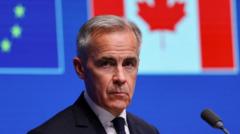In a significant economic maneuver, Prime Minister Mark Carney has initiated a plan aimed at strengthening Canada's domestic trade as a response to U.S. tariffs under President Trump. This initiative intends to eliminate age-old internal trade barriers by July 1. Despite these efforts, analysts caution that such measures may not adequately compensate for the losses in trade with the U.S.
Canada's Strategy to Counter U.S. Tariffs: Boosting Domestic Trade

Canada's Strategy to Counter U.S. Tariffs: Boosting Domestic Trade
Prime Minister Mark Carney aims to dismantle internal trade barriers by Canada Day, but experts warn it won't replace U.S. trade losses.
Carney, who has transitioned from a career in banking to politics, laid out his vision in the spring of his leadership, suggesting that increased inter-provincial commerce could mitigate the negative impacts of U.S. tariffs on Canadian exports. In a statement, he emphasized the importance of creating a unified Canadian economy, aiming to position it as the most robust within the G7 nations.
However, challenges persist as each of Canada's ten provinces and three territories has established its own set of regulations, complicating the internal trade landscape significantly. Economists widely agree that relaxing these barriers would be beneficial, yet the vast geographical size of Canada and its relatively small market hinder the potential for domestic trade to fill the gap left by U.S. market losses.
While Carney’s government has successfully passed a bill aimed at reducing federal trade restrictions, the broader provincial regulations remain a pivotal issue. Most experts agree that, although internal trade growth is a sound policy approach, it will likely take time and further cooperation among provinces to see substantial benefits, making it an inadequate substitute for the crucial U.S. trade partnerships.
As Canada grapples with this complex scenario, the focus will remain on how effectively it can adapt and strengthen its local economy while navigating international economic pressures.
However, challenges persist as each of Canada's ten provinces and three territories has established its own set of regulations, complicating the internal trade landscape significantly. Economists widely agree that relaxing these barriers would be beneficial, yet the vast geographical size of Canada and its relatively small market hinder the potential for domestic trade to fill the gap left by U.S. market losses.
While Carney’s government has successfully passed a bill aimed at reducing federal trade restrictions, the broader provincial regulations remain a pivotal issue. Most experts agree that, although internal trade growth is a sound policy approach, it will likely take time and further cooperation among provinces to see substantial benefits, making it an inadequate substitute for the crucial U.S. trade partnerships.
As Canada grapples with this complex scenario, the focus will remain on how effectively it can adapt and strengthen its local economy while navigating international economic pressures.





















